Everyone at a corporate office has a specific role and something they’re good at – AI agents aren’t so different. Just like a receptionist manages calls, a team lead delegates work, and specialists focus on their areas of expertise, AI agents can work together to handle different tasks efficiently. Instead of relying on one system to do everything, businesses can deploy multiple AI agents, each designed for a specific job, to create smarter workflows.
By 2027, it’s anticipated that 50% of companies using generative AI will have initiated projects with autonomous AI agents. But what exactly are these AI agents, and how do they differ from traditional AI systems? Traditional AI innovations analyze data to provide insights but rely on humans to act on them. AI agents go a step further – they analyze, decide, and take action autonomously. They don’t just highlight trends; they optimize workflows, automate tasks, and handle business processes independently.
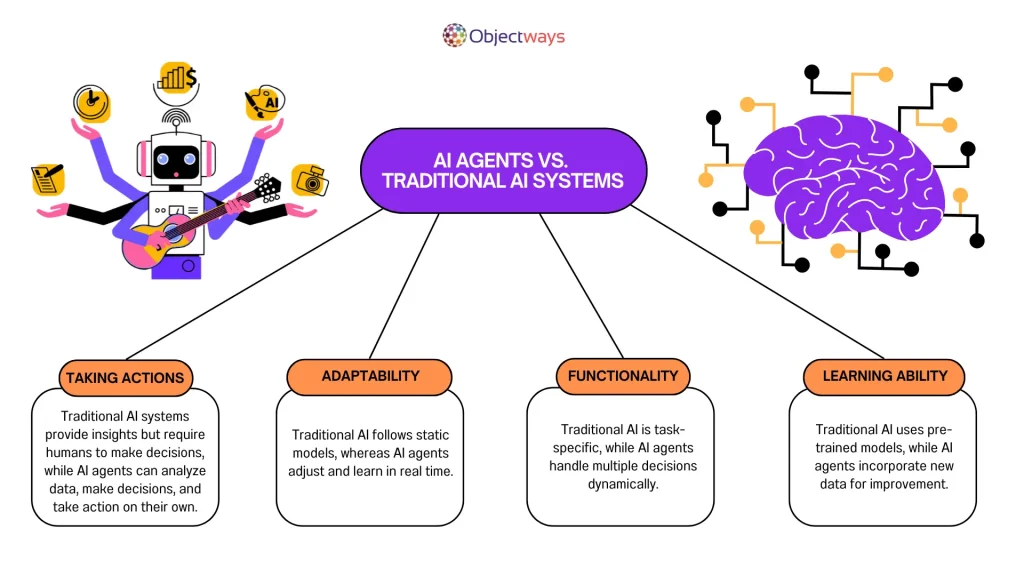
As businesses adopt these new team players, the AI agents market is expected to reach $47.1 billion by 2030. AI technologies like natural language processing (NLP), large language models (LLMs), and computer vision enable these agents to understand, process, and act on information. However, to perform at their best, AI agents need to be trained on high-quality data, and that’s where data labeling becomes key.
Data labeling involves tagging raw data with meaningful labels, helping AI agents learn, improve, and make better decisions – just like employees need proper training to do their jobs well. Since curating high-quality data isn’t always easy, many businesses often turn to experts like Objectways for support. With over five years of experience and a team of 2,200+ specialists, Objectways provides precise and scalable data labeling solutions for various AI technologies.
In this article, we’ll explore different types of AI agents, their real-world applications, and why data labeling is key to their success. Let’s get started!
An AI agent is an intelligent system that performs tasks independently within its environment. It gathers information, makes decisions, and adapts to changing conditions. Some advanced AI agents can even learn and improve over time, constantly adjusting their approach to get better results.
Next, let’s take a closer look at the different types of AI agents.
A reactive agent, also known as a simple reflex agent, is the most basic type of AI agent. They respond the same way to specific inputs, like a security guard at an office who always checks IDs before allowing entry, following a fixed set of rules.
These systems focus on specific tasks and process large amounts of data to get the job done. However, they don’t have memory and don’t use past data to improve their decisions. A good example is an email spam filter, which simply checks each email against set rules to decide if it’s spam. It analyzes factors like keywords, sender details, and attachments but does not learn from previous emails or adapt over time.
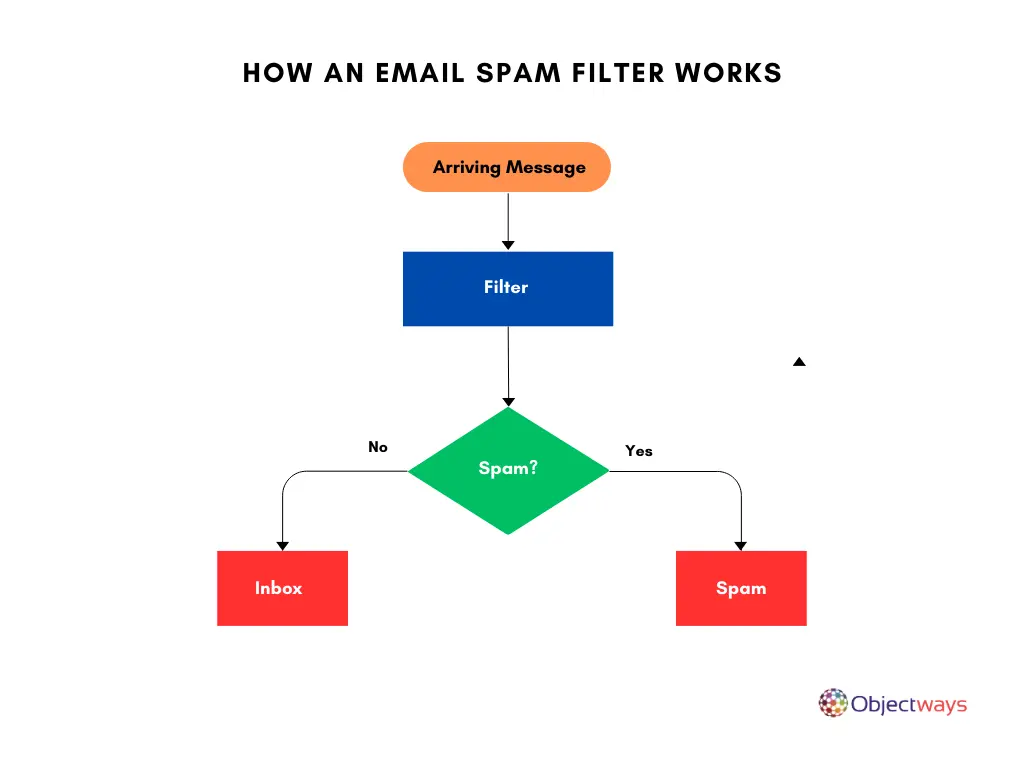
Unlike the basic reactive agents, limited memory agents are a little more complex. They can access past information, combine it with present data, and make informed decisions for a task. You can think of this agent as a receptionist who remembers frequent visitors, greeting them by name and directing them to the right person without asking again. By using past interactions, they make the process smoother and more efficient.
Also, just like a receptionist might not remember a visitor from a year ago, these agents have limited memory and don’t store information long-term. A good example of a limited memory AI agent is a chatbot. It remembers what you’ve said during a conversation, so it can respond in a way that makes sense. But once the chat ends, it forgets everything and starts fresh next time. This keeps it helpful in the moment without storing long-term data.
The next set of AI agents, cognitive and model-based agents, have more knowledge and autonomy than the ones we discussed previously. These agents don’t just react to inputs or rely on short-term memory – they analyze, plan, and make informed decisions based on stored experiences. They function more like experienced managers in an office, who handle day-to-day tasks, anticipate future challenges, and adjust strategies accordingly.
Model-based agents use AI models trained on high-quality datasets to make well-informed decisions. They can analyze patterns like a logistics manager optimizing delivery routes based on past and present conditions.
Cognitive agents, on the other hand, focus on human-like interactions using AI models to process requests and respond naturally. They can be compared with customer service representatives who understand requests, engage with users, and provide personal assistance. Together, they create a smarter, more efficient AI system – just like a well-coordinated office team where decision-making and communication work seamlessly.
A utility-based agent is like a director in an office who carefully evaluates different options before making the best decision for the company. But what exactly is a utility function? It’s a way to measure the potential success of each choice, helping the agent decide which action will have the best outcome.
Just like a director who considers factors like budget, team capacity, and business goals before approving a project, a utility-based agent analyzes different possibilities, weighs trade-offs, and picks the best option. This makes them ideal for complex decisions, such as financial trading systems that maximize profit while managing risk.
With respect to computer vision, a branch of AI that helps machines understand visual information, utility-based agents are used to make smart decisions based on what they see. For example, when it comes to autonomous drones used for surveillance, the agent might consider things like battery life, image quality, weather, and obstacles before deciding the best flight path. It continuously evaluates these factors to make sure the drone covers the most area efficiently while saving energy and avoiding obstacles.
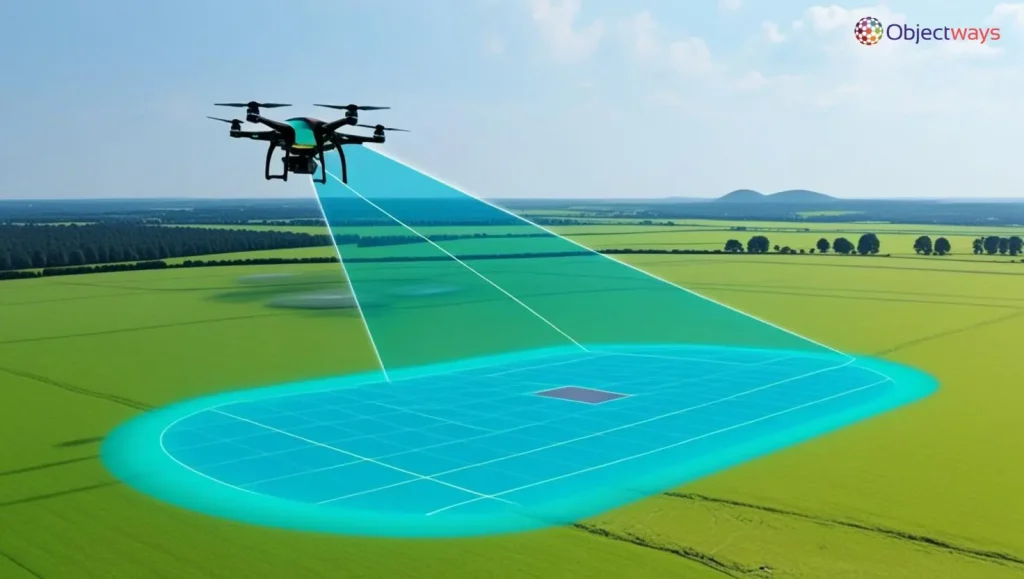
In an office setting, any team’s goal is often to complete a project successfully. However, the way they go about it can differ based on their approach. Similarly, goal-based and utility-based AI agents aim to achieve a specific outcome, but their methods differ.
A goal-based agent is designed to focus entirely on achieving a clear, predefined objective. If a drone were goal-based, its only objective would be to deliver a package to a specific location. It would follow a predefined path, adjusting only when necessary to avoid obstacles or other immediate issues. The goal is straightforward, and the drone focuses entirely on reaching that destination, taking the simplest route that gets the job done.
In contrast, if the drone were utility-based, it would continuously evaluate multiple factors along its journey – battery life, weather conditions, traffic in the area, and potential obstacles – and make decisions to maximize its overall efficiency.
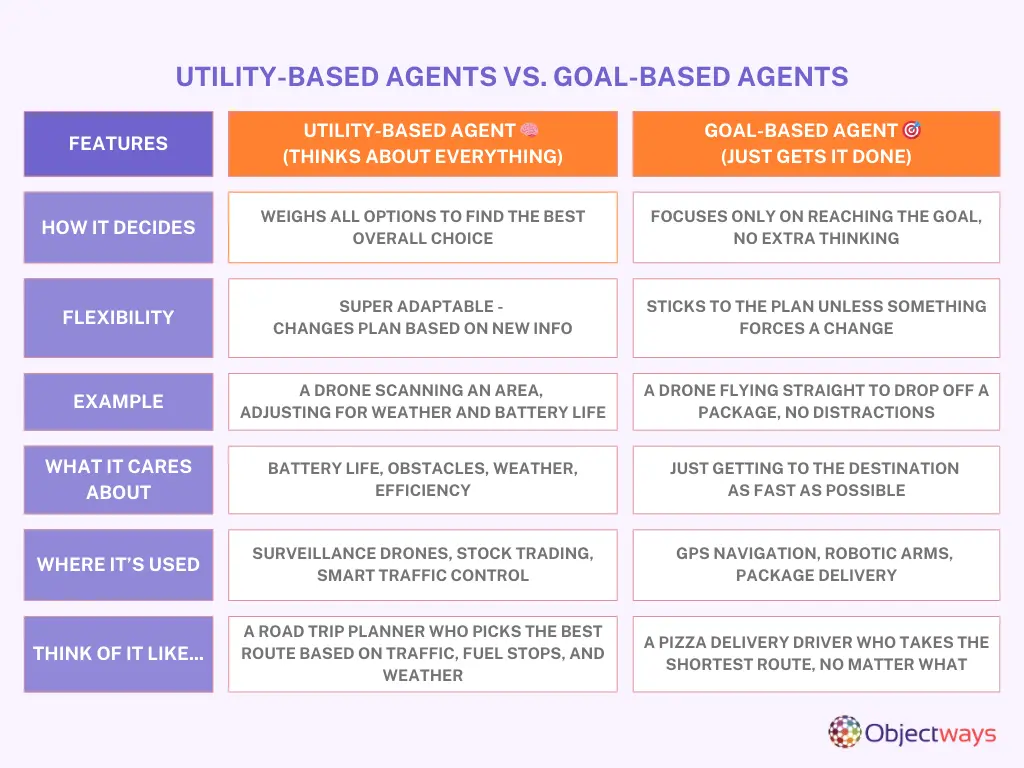
Successful business professionals aren’t experts from the get-go; they refine their skills through experience, learning from each project and challenge to become top performers. Learning agents work similarly. They are among the most advanced types of AI agents and can learn and improve over time as they gain more experience.
An interesting example of AI in manufacturing quality control systems that use learning agents to enhance defect detection and ensure higher production standards. These agents rely on computer vision to inspect products and identify defects. As the system processes more images, the learning agent gets better at spotting imperfections over time. When a defect is detected, the agent can automatically flag the item, initiate a rejection process, or even suggest corrective actions to improve manufacturing quality.

Now that we’ve discussed what AI agents are and the different types of agents, let’s take a closer look at their benefits. Here are some ways AI agents can impact businesses:
Next, let’s walk through some real-world applications of AI agents across different industries. From inventory management to customer service, AI agents are slowly becoming central to how companies work.
AI agents can be used to manage supply chains in the manufacturing industry. They can easily track supply levels within the inventory, and if the agent detects that the supplies are low, the agent can automatically take action by sending restocking orders to workers. They can also boost quality control by simplifying the inspection process.
How does this work? AI agents achieve this by using sensors and real-time data analytics to monitor inventory levels and product quality. If an item is defective, the AI agent can flag it instantly, reducing waste. Similarly, when stock is running low, the system can automatically place an order, keeping operations running smoothly and avoiding delays.
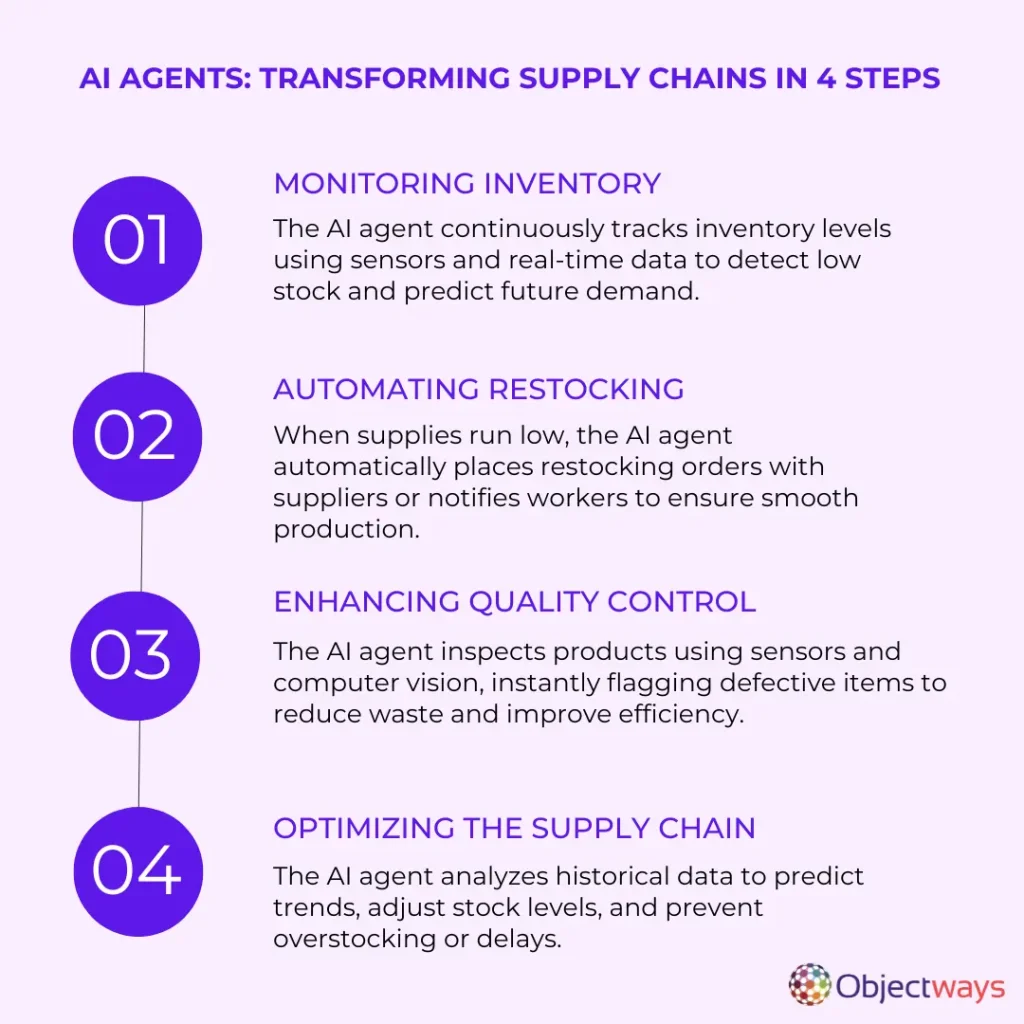
AI agents are also helping out with operations within the HR department of various companies. They can be integrated into job portals to automatically update postings, generate candidate shortlists, and streamline onboarding.
By quickly screening thousands of job applications, AI agents identify the best candidates based on the company’s preferred skills and can automatically schedule interviews or send rejection emails, significantly reducing hiring time. On top of that, AI chatbots can assist employees by answering queries about job positions, including salary packages, company policies, benefits, and training opportunities, while also directing complex inquiries to the appropriate HR personnel.
Even though AI agents are a relatively recent AI development, they are already making a significant impact in the customer service sector. These intelligent systems are redefining support operations by providing instant responses, automating routine tasks, and enhancing customer interactions.
For instance, When the COVID-19 pandemic hit, Lufthansa (a German aviation group) was flooded with calls from passengers trying to rebook flights, get refunds, or check travel updates. Their existing systems couldn’t keep up, so they brought in AI agents to help. The AI agents gave passengers access to real-time information and were able to manage bookings seamlessly across multiple platforms.
In fact, Lufthansa’s AI agents were able to handle over 10 million conversations a year, drastically cutting wait times and streamlining support. During peak periods, they managed up to 360,000 interactions daily and made sure passengers got the help they needed without delays.
To get a better understanding of how AI agents like the ones Lufthansa uses work, we can compare them to the types we discussed earlier:
By working together, AI agents like these help companies deliver faster, more efficient, and more scalable customer support, reducing wait times and improving the overall customer experience.
Now that we’ve seen how AI agents are used, let’s focus on an essential step in building them – data labeling. At the core of every intelligent AI agent is an AI model, and for these models to perform well, they need high-quality labeled data to learn from and recognize patterns.
Here are a few reasons why data labeling is so important:
Sourcing and labeling data isn’t as easy as it sounds, even with all its benefits. One of the biggest challenges is making sure the data is high quality. If an AI model learns from poor-quality data, it’s going to give poor results (just like the saying, “garbage in, garbage out”).
Oftentimes, companies need skilled data annotators and AI experts to handle massive datasets, fix errors, and understand industry-specific details. On top of that, there’s the challenge of following strict data security laws like GDPR, CCPA, and DPA. As these regulations get tighter, companies have to be extra careful about protecting data.
At Objectways, we are committed to supporting you and helping you navigate these challenges. We handle your data labeling needs with precision and care. Our highly skilled annotators and AI experts are equipped to manage even the most complex labeling tasks while ensuring full compliance with data security regulations. With our expertise, you can stay focused on AI agent development while we take care of the rest.
Here are some more reasons to choose Objectways for data labeling:
We’ve discussed how AI agents are transforming industries by handling complex tasks and giving employees more time to focus on important work. However, for AI agents to function well, they require high-quality labeled data for proper model training. While challenges such as finding skilled workers and adhering to data security regulations can make this process difficult, accurate labeling remains vital for AI development.
Objectways makes this easier by offering expert data labeling services, so businesses can focus on growing while staying compliant and accurate. With high-quality data, AI agents can continuously improve, delivering more accurate and reliable solutions across various industries.
Looking to bring your AI solutions to life? Contact Objectways today, and let’s talk about how our data labeling solutions can support your success!
